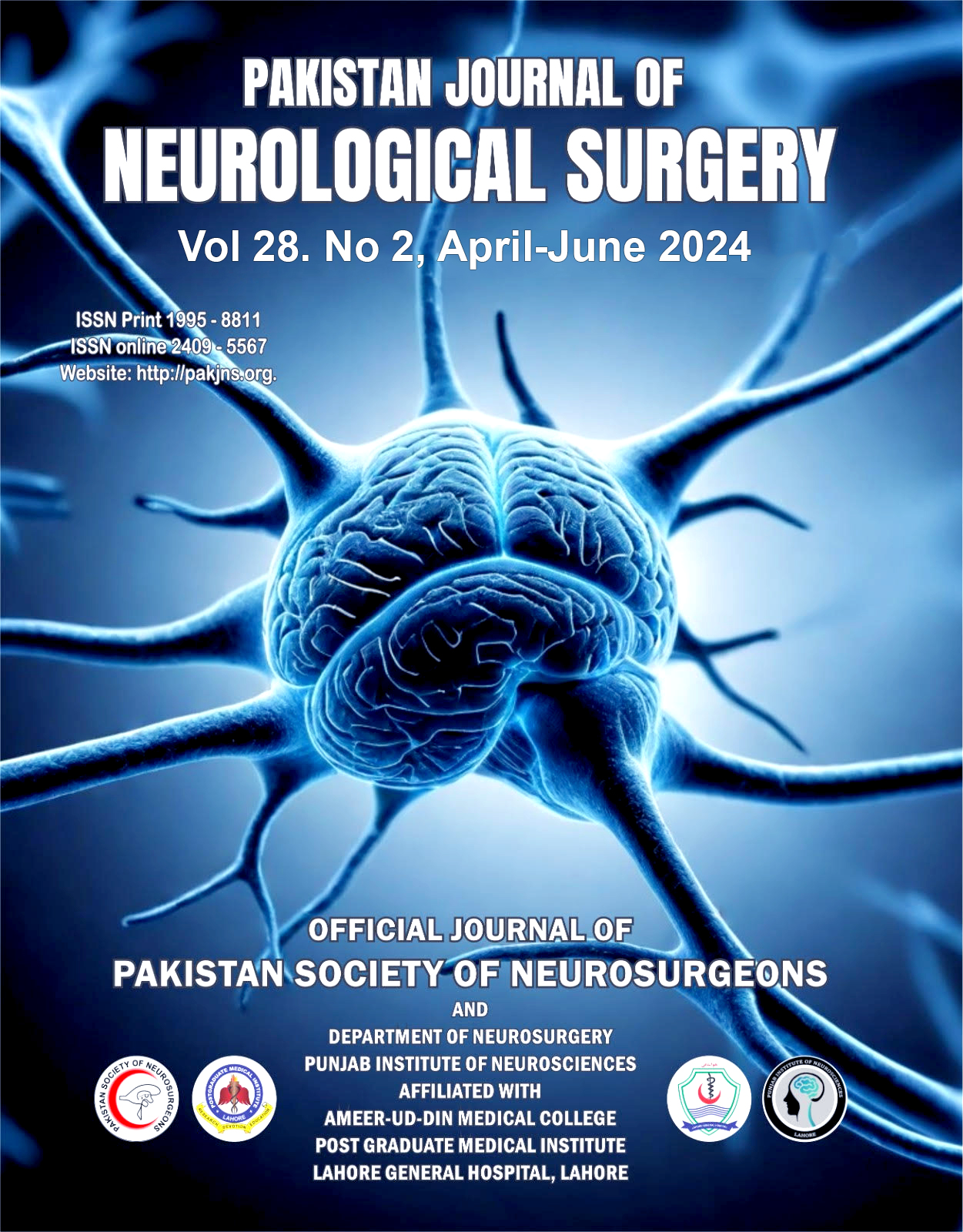A Study on Ocular Manifestations Seen in Patients with Cerebral Palsy
DOI:
https://doi.org/10.36552/pjns.v28i2.980Keywords:
Cerebral Palsy, Ocular, Neurological deficitAbstract
Background: Cerebral palsy (CP) encompasses various neurological disorders like abnormal brain development or permanent brain damage, impacting muscle tone, and motor function. This study assessed ocular manifestations in patients with CP, including visual acuity, refractive errors, ocular alignment, and anterior and posterior eye segments.
Materials & Methods: This retrospective study was conducted at the Department of Ophthalmology Khyber Teaching Hospital (KTH) from 1st November 2022 to 30th September 2023. Data collected included detailed medical, ocular, and birth histories, age and gender of the patient, type of CP, visual acuity (VA) if possible, type of refractive error, ocular alignment and motility and anterior and posterior segments examination of the eyes. Data analysis was done using SPSS version 23.
Results: The study included 40 patients of which twenty-nine (72.5%) were male. The study found spastic CP to be the most prevalent in 23 (57.5%) patients followed by hypotonic CP 12 (30%) and mixed type 5 (12%). VA was examined in CP patients over 4 years with a mean VA of 0.6 and a range of 0.0 to 0.8 LogMAR. Strabismus was found in 33(82.5%) patients with esotropia being the most common in 21 (52.5%) patients, exotropia in 6 (15.0%) patients, and vertical deviation in 6 (15.0%) patients. Ocular motility defect of abduction deficit was found in 2 (5%) patients. Other findings included ptosis in 1(2.5%), nystagmus in 2(5%).
Conclusion: Most children with cerebral palsy exhibit ocular abnormalities, necessitating regular ophthalmic examinations to prevent life-long visual disabilities/complications and to support their overall development.
References
Sadowska M, Sarecka-Hujar B, Kopyta I. Cerebral palsy: current opinions on definition, epidemiology, risk factors, classification and treatment options. Neuropsychiatric disease and treatment. 2020:1505-18.
https://doi.org/10.2147/NDT.S235165
Vitrikas K, Dalton H, Breish D. Cerebral palsy: an overview. American family physician. 2020;101(4):213-20. PMID: 32053326
Park MJ, Yoo YJ, Chung CY, Hwang J-M. Ocular findings in patients with spastic type cerebral palsy. BMC Ophthalmology. 2016;16(1):195.
DOI: 10.1186/s12886-016-0367-1
Herron MS, Wang L, von Bartheld CS. Prevalence and Types of Strabismus in Cerebral Palsy: A Global and Historical Perspective Based on a Systematic Review and Meta-Analysis. Ophthalmic Epidemiol. 2024:1-18.
DOI: 10.1101/2024.01.23.24301684
Garfinkle J, Li P, Boychuck Z, Bussières A, Majnemer A. Early clinical features of cerebral palsy in children without perinatal risk factors: a scoping review. Pediatric neurology. 2020;102:56-61. https://doi.org/10.1016/j.pediatrneurol.2019.07.006
Upadhyay J, Tiwari N, Ansari MN. Cerebral palsy: Aetiology, pathophysiology and therapeutic interventions. Clinical and Experimental Pharmacology and Physiology. 2020;47(12):1891-901. DOI: 10.1111/1440-1681.13379
Katoch S, Devi A, Kulkarni P. Ocular defects in cerebral palsy. Indian journal of ophthalmology. 2007;55(2):154-6. DOI: 10.4103/0301-4738.30717
Bodunde O, Ademola-Popoopla D, Ojuawo A, Adeboye M. Ocular findings in children with cerebral palsy attending a tertiary hospital in North central Nigeria. Sierra Leone Journal of Biomedical Research. 2015;7(2):1-7.
Bala I, Tuli R, Dhiman I, Sharma R, Gautam P. A
Study of Ocular Abnormalities in Children with Cerebral Palsy. Age. 1(2yrs):2-6yrs.
www.dosonline.org/dos-times
Striber N, Vulin K, ?akovi? I, Prv?i? I, ?uranovi? V, Cerovski B, et al. Visual impairment in children with cerebral palsy: Croatian population-based study for birth years 2003-2008. Croatian Medical Journal. 2019;60(5):414-20.
Doi: 10.3325/cmj.2019.60.414
Fazzi E, Signorini SG, La Piana R, Bertone C, Misefari W, Galli J, et al. Neuro?ophthalmological disorders in cerebral palsy: ophthalmological, oculomotor, and visual aspects. Developmental Medicine & Child Neurology. 2012;54(8):730-6. Doi: 10.1111/j.1469-8749.2012.04324.x
Park MJ, Yoo YJ, Chung CY, Hwang J-M. Ocular findings in patients with spastic type cerebral palsy. BMC ophthalmology. 2016;16(1):1-6.
Doi: 10.1186/s12886-016-0367-1
Heydarian S, Abbasabadi MM, Khabazkhoob M, Hoseini-Yazdi H, Gharib M, editors. Vision abnormalities in children and young adults with cerebral palsy; a systematic review. Seminars in Ophthalmology; 2022: Taylor & Francis.
Doi: 10.1080/08820538.2021.2021248
Dahl S, Kristoffersen Wiberg M, Teär Fahnehjelm K, Sävendahl L, Wickström R. High prevalence of pituitary hormone deficiency in both unilateral and bilateral optic nerve hypoplasia. Acta Paediatrica. 2019;108(9):1677-85. Doi: 10.1111/apa.14751
Ullah Z, Naseer R. Blindness and Visual Impairments Causes in Patients Presenting to Tertiary Eye Care Centers of Peshawar. National Journal of Life and Health Sciences. 2022;1(2):16-9. Doi: https://doi.org/10.62746/njlhs.v1n2.41
Downloads
Published
Issue
Section
License
Copyright (c) 2024 Nazli Gul, Muhammad Rizwan, Yasmeen, Momina Haq, Anam Haq, Imran AhmedThe work published by PJNS is licensed under a Creative Commons Attribution-NonCommercial 4.0 International (CC BY-NC 4.0). Copyrights on any open access article published by Pakistan Journal of Neurological Surgery are retained by the author(s).













